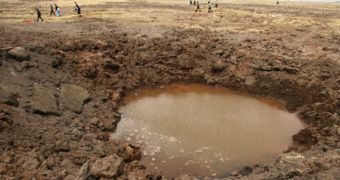You might not know this, but in September 2007 a meteorite entered the Earth's atmosphere and eventually reached the ground in a countryside area in Peru, where it formed a small crater, right in front of the eyes of the people living nearby. And this occurred although most of the space rocks hitting our planet usually burn into the atmosphere long before reaching the ground, at altitudes from 50 to 70 kilometers above the ground. This implies that the object would have moved with a relative reduced speed during the entry, but much to the scientists' surprise, this particular rock seems to have traveled at a much faster speed for it to survive the fall.
Brown University planetary geologist Peter Schultz, who went specially to Peru to study the crater created by the impact said: "Many people thought this was a fake. It just didn't make sense with what we understand of collisions with this type of fragile rock." The immense pressure being exerted during the fall should immediately break the rock apart, but, from time to time, exceptions do happen.
Upon studying the crater, Schultz revealed that the distinctive fractured lines in sand grains and the mixtures of soil and meteorite fragments spread in the vicinity of the crater suggest an impact speed of about 24,000 kilometers per hour. Analysis of the composition of the meteorite suggest a type of common meteorite, formed by silicate rock, or stony meteorite. Such objects do not usually have the momentum to break certain speed barriers while traveling through the atmosphere and, by the time the impact occurred, it would have lost enough mass to reduce the speed to normal levels, or at terminal speed, not enough to determine the formation of a crater as we know it, but a mere hole in the ground.
The fact is there is nothing special about the meteorite to suggest that it would have had the capability of penetrating all the way through the atmosphere to hit the ground.
One of the solutions proposed by astrophysicists take into consideration the possibility that, while traveling through the atmosphere, the meteorite was melted by the intense heat, and re-shaped into an aerodynamic needle-shape, which would give it the ability to reach the ground in one piece and maintain its original speed without suffering the severe effects of dragging. The problem is, if this wouldn't be a special object, than all rocky meteorites of similar dimensions should behave in this manner, which is obviously untrue.
Another key characteristic would be the angle of attack while entering the atmosphere, according to Schultz. This might just be the event which could change our understanding of interactions between Earth and small meteorites, or craters such as that in the Carancas site in Peru. The crater has filled with water since then, but it could still contain some amounts of rock powder from the original object.

 14 DAY TRIAL //
14 DAY TRIAL //